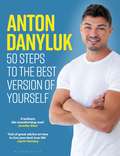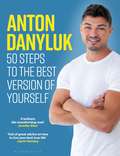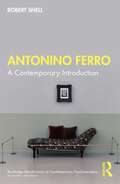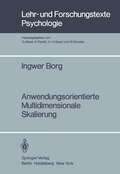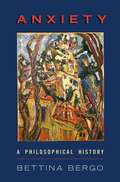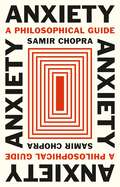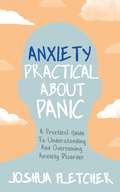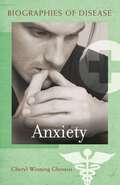- Table View
- List View
The Antisocial Personalities
by David T. LykkenThis volume presents a scholarly analysis of psychopathic and sociopathic personalities and the conditions that give rise to them. In so doing, it offers a coherent theoretical and developmental analysis of socialization and its vicissitudes, and of the role played in socialization by the crime-relevant genetic traits of the child and the skills and limitations of the primary socializing agents, the parents. This volume also describes how American psychiatry's (DSM-IV) category of "Antisocial Personality Disorder" is heterogeneous and fails to document some of the more interesting and notorious psychopaths of our era. The author also shows why the antinomic formula "Nature vs. Nurture" should be revised to "Nature via Nurture" and reviews the evidence for the heritability of crime-relevant traits. One of these traits -- fearlessness -- seems to be one basis for the primary psychopathy and the author argues that the primary psychopath and the hero may be twigs on the same genetic branch. But crime -- the failure of socialization -- is rare among traditional peoples still living in the extended-family environment in which our common ancestors lived and to which our species is evolutionarily adapted. The author demonstrates that the sharp rise in crime and violence in the United States since the 1960s can be attributed to the coeval increase in divorce and illegitimacy which has left millions of fatherless children to be reared by over-burdened, often immature or sociopathic single mothers. The genus sociopathic personality includes those persons whose failure of socialization can be attributed largely to incompetent or indifferent rearing. Two generalizations supported by modern behavior genetic research are that most psychological traits have strong genetic roots and show little lasting influence of the rearing environment. This book demonstrates that the important trait of socialization is an exception. Although traits that obstruct or facilitate socialization tend to obey these rules, socialization itself is only weakly heritable; this is because modern American society displays such enormous variance in the relevant environmental factors, mainly in parental competence. Moreover, parental incompetence that produces sociopathy in one child is likely to have the same result with any siblings. This book argues that sociopathy contributes far more to crime and violence than psychopathy because sociopaths are much more numerous and because sociopathy is a familial trait for both genetic and environmental reasons. With a provocative thesis and an engaging style, this book will be of principal interest to clinical, personality, forensic, and developmental psychologists and their students, as well as to psychiatrists and criminologists.
The Antisocial Personalities
by David T. LykkenThis volume presents a scholarly analysis of psychopathic and sociopathic personalities and the conditions that give rise to them. In so doing, it offers a coherent theoretical and developmental analysis of socialization and its vicissitudes, and of the role played in socialization by the crime-relevant genetic traits of the child and the skills and limitations of the primary socializing agents, the parents. This volume also describes how American psychiatry's (DSM-IV) category of "Antisocial Personality Disorder" is heterogeneous and fails to document some of the more interesting and notorious psychopaths of our era. The author also shows why the antinomic formula "Nature vs. Nurture" should be revised to "Nature via Nurture" and reviews the evidence for the heritability of crime-relevant traits. One of these traits -- fearlessness -- seems to be one basis for the primary psychopathy and the author argues that the primary psychopath and the hero may be twigs on the same genetic branch. But crime -- the failure of socialization -- is rare among traditional peoples still living in the extended-family environment in which our common ancestors lived and to which our species is evolutionarily adapted. The author demonstrates that the sharp rise in crime and violence in the United States since the 1960s can be attributed to the coeval increase in divorce and illegitimacy which has left millions of fatherless children to be reared by over-burdened, often immature or sociopathic single mothers. The genus sociopathic personality includes those persons whose failure of socialization can be attributed largely to incompetent or indifferent rearing. Two generalizations supported by modern behavior genetic research are that most psychological traits have strong genetic roots and show little lasting influence of the rearing environment. This book demonstrates that the important trait of socialization is an exception. Although traits that obstruct or facilitate socialization tend to obey these rules, socialization itself is only weakly heritable; this is because modern American society displays such enormous variance in the relevant environmental factors, mainly in parental competence. Moreover, parental incompetence that produces sociopathy in one child is likely to have the same result with any siblings. This book argues that sociopathy contributes far more to crime and violence than psychopathy because sociopaths are much more numerous and because sociopathy is a familial trait for both genetic and environmental reasons. With a provocative thesis and an engaging style, this book will be of principal interest to clinical, personality, forensic, and developmental psychologists and their students, as well as to psychiatrists and criminologists.
Antisoziales: Eine Kurzanalyse aus der Perspektive der „Dunklen Triade“ (essentials)
by Karin MeyerNarzissmus gilt auf Führungsetagen als ein verbreitetes Phänomen, das dort im Vergleich zur restlichen Bevölkerung überdurchschnittlich stark repräsentiert ist. Weiterhin weisen jüngere Nachwuchs(führungs-)kräfte deutlich höhere Narzissmus-Ausprägungen auf als dies in den älteren Generationen bislang der Fall war. Gleichzeitig treten Verhaltenszüge der Dunklen Triade (Narzissmus, Machiavellismus und Psychopathie) meist nicht isoliert, sondern in Kombination auf. Unternehmen sollten aus diesem Grund schon heute ihre Personalauswahl, -führung und -entwicklung überdenken. Beleuchtet werden daher Merkmale und Verhaltensmuster rücksichtsloser Personen der Dunklen Triade – ebenso mögliche Ansätze zur Intervention und Prävention.
Anton Danyluk: 50 Steps to the Best Version of Yourself
by Anton Danyluk'A brilliant, life-transforming read' – Jennifer West'Full of great advice on how to live your best true life' – Jaymi HensleyAnton Danyluk has been on an incredible journey, from awkward, overweight teenager to World Merit ambassador, Love Island favourite, Instagram star and respected fitness trainer. Having overcome his own personal challenges, Anton sets out the simple steps you can take to feel good about yourself every day. Anton is on a mission to encourage others who are struggling with their wellbeing and fitness, and wants to help everyone live healthy and happy lifestyles – and if Anton can do it, so can you. Open and honest, engaging and relatable, this part-practical, part-autobiographical book will motivate and empower you on the journey towards your best self.- Develop a strong sense of who you really are- Embrace opportunity – and you'll never fear failure again- Make exercise your medicine – you won't believe how good you can feel- Get the body you want – without going to extremesAnton's level-headed and achievable advice has everything you need to feel good, look great and live the best version of yourself.
Anton Danyluk: 50 Steps to the Best Version of Yourself
by Anton Danyluk'A brilliant, life-transforming read' – Jennifer West'Full of great advice on how to live your best true life' – Jaymi HensleyAnton Danyluk has been on an incredible journey, from awkward, overweight teenager to World Merit ambassador, Love Island favourite, Instagram star and respected fitness trainer. Having overcome his own personal challenges, Anton sets out the simple steps you can take to feel good about yourself every day. Anton is on a mission to encourage others who are struggling with their wellbeing and fitness, and wants to help everyone live healthy and happy lifestyles – and if Anton can do it, so can you. Open and honest, engaging and relatable, this part-practical, part-autobiographical book will motivate and empower you on the journey towards your best self.- Develop a strong sense of who you really are- Embrace opportunity – and you'll never fear failure again- Make exercise your medicine – you won't believe how good you can feel- Get the body you want – without going to extremesAnton's level-headed and achievable advice has everything you need to feel good, look great and live the best version of yourself.
Antonino Ferro: A Contemporary Introduction (Routledge Introductions to Contemporary Psychoanalysis)
by Robert SnellThis book provides a clear, thorough, and accessible introduction to the work of Antonino Ferro and draws on the clinical vignettes that punctuate his writings to show how Ferro has built on Bion’s revolutionary achievements to develop a distinctive, game-changing version of field theory in psychoanalysis.The book clarifies the phenomenological insight that the analyst and the patient together generate an ever-evolving, intersubjective field. Rather than the supposed psychology of the individual, it is this populous and multidimensional field, a co-created ‘in-between’ rich in characters and stories, that is to be explored and elaborated. The primary points of access to this new ‘multiverse’ are dream, reverie, metaphor, and imagination. A radical Negative Capability is called for, not least to help dissolve co-constructed ‘bastions’ obstructing the field’s expansion. The book sketches out the Italian and international context in which Ferro developed his thinking and addresses some key critical questions. It concludes that Ferro’s life’s work, which marries theoretical rigour with a revitalising increase in playfulness and freedom of response, is a transformational force within psychoanalysis and a major catalyst in its evolution.This important volume is rewarding reading for beginning and seasoned analysts alike, as well as for psychotherapists, counsellors, humanities scholars, and anyone interested in psychoanalysis.
Antonino Ferro: A Contemporary Introduction (Routledge Introductions to Contemporary Psychoanalysis)
by Robert SnellThis book provides a clear, thorough, and accessible introduction to the work of Antonino Ferro and draws on the clinical vignettes that punctuate his writings to show how Ferro has built on Bion’s revolutionary achievements to develop a distinctive, game-changing version of field theory in psychoanalysis.The book clarifies the phenomenological insight that the analyst and the patient together generate an ever-evolving, intersubjective field. Rather than the supposed psychology of the individual, it is this populous and multidimensional field, a co-created ‘in-between’ rich in characters and stories, that is to be explored and elaborated. The primary points of access to this new ‘multiverse’ are dream, reverie, metaphor, and imagination. A radical Negative Capability is called for, not least to help dissolve co-constructed ‘bastions’ obstructing the field’s expansion. The book sketches out the Italian and international context in which Ferro developed his thinking and addresses some key critical questions. It concludes that Ferro’s life’s work, which marries theoretical rigour with a revitalising increase in playfulness and freedom of response, is a transformational force within psychoanalysis and a major catalyst in its evolution.This important volume is rewarding reading for beginning and seasoned analysts alike, as well as for psychotherapists, counsellors, humanities scholars, and anyone interested in psychoanalysis.
Antwortreaktionszeiten in Survey-Analysen: Messung, Auswertung und Anwendungen
by Jochen Mayerl Dieter UrbanDas Buch erläutert das „Wie und Warum“ der Messung und Analyse von Antwortreaktionszeiten für computergestützte Bevölkerungsumfragen. Verfahren zur empirischen Erhebung von Antwortreaktionszeiten (z.B. aktive oder passive Zeitmessmethoden) werden ebenso erläutert wie statistische Methoden zur Behandlung und Bereinigung der erhobenen Reaktionszeiten (z.B. Operationalisierung und Kontrolle individueller Basisgeschwindigkeiten und statistische Identifizierung ungültiger Zeitmessungen). Das Buch beschreibt viele Anwendungsbeispiele von Reaktionszeitanalysen aus der aktuellen Forschungspraxis. Anwendungen aus der Einstellungs- und Verhaltensforschung und der Untersuchung von Befragtenverhalten (z.B. Aufdecken von Response-Effekten) verdeutlichen, welch vielfältige Möglichkeiten die Auswertung von Reaktionszeitmessungen zur Verbesserung von Survey-Analysen eröffnet.
Anwenderakzeptanz unternehmensweiter Standardsoftware: Theorie, Einflussfaktoren und Handlungsempfehlungen
by Oliver KohnkeMit einer theoretisch fundierten Untersuchung der Einflussfaktoren auf die Anwenderakzeptanz von Standardsoftware behandelt Oliver Kohnke ein höchst praxisrelevantes Thema. An der Schnittstelle zwischen IT und Psychologie nutzt er ein erweitertes „Technology Acceptance Model (TAM)“, um zu analysieren, wie Anwenderakzeptanz entsteht und gezielt beeinflusst werden kann. Dabei liefert der Autor für den deutschsprachigen Raum erstmals eine zusammenfassende Darstellung des Forschungsstands zum TAM und reflektiert das Modell kritisch vor dem Hintergrund aktueller sozialpsychologischer Erkenntnisse. Die Datenerhebung erfolgte im Rahmen mehrerer internationaler Studien, davon eine Längsschnittstudie. Aufgrund der großen Stichproben konnte der Autor anspruchsvolle statistische Verfahren einsetzen, die er umfassend erläutert
Anwendung des Genome Editing in der somatischen Gentherapie: Eine Einführung (essentials)
by Boris Fehse Ulrike Abramowski-MockDieses essential gibt einen Überblick über Grundlagen sowie Chancen und Risiken der Gentherapie, mit besonderem Fokus auf das Genome Editing. Es werden aktuelle und zukünftige klinische Anwendungen der neuen, mit vielen Hoffnungen, aber auch Ängsten verbundenen Technologien diskutiert.
Anwendungsfelder der medizinischen Psychologie
by Friedrich BalckIm ärztlich-medizinischen Berufsfeld wird häufig unterschätzt, wie eng körperliche Krankheiten mit psychischen Vorgängen verknüpft sind. Das Fachgebiet der medizinischen Psychologie setzt an den zahlreichen Berührungspunkten zwischen Medizin und Psychologie an: den Auswirkungen körperlicher Erkrankungen oder medizinischer Eingriffe auf das psychische Erleben und Befinden, den Einfluss psychischer Zustände auf Entstehung und Verlauf von Erkrankungen oder die zwischenmenschlichen Beziehungen zwischen Ärzten, Patienten und Angehörigen. In diesem Buch beleuchten führende Vertreter des Faches solche medizinpsychologischen Fragen und Erkenntnisse erstmals getrennt für spezifische, medizinische Anwendungsgebiete: Was hat die Psychologie u.a. zur Onkologie, Kardiologie, Zahnmedizin, Augenheilkunde oder auch zu Themen wie "Sterben, Tod und Trauern" und "Telemedizin" zu sagen? Wie tragen z.B. psychische Faktoren zur Entstehung einer Herzinsuffizienz oder der Migräne bei?
Anwendungsorientierte Multidimensionale Skalierung (Lehr- und Forschungstexte Psychologie #1)
by I. BorgAnxiety: A Philosophical History
by Bettina BergoAnxiety looms large in historical works of philosophy and psychology. It is an affect, philosopher Bettina Bergo argues, subtler and more persistent than our emotions, and points toward the intersection of embodiment and cognition. While scholars who focus on the work of luminaries as Freud, Levinas, or Kant often study this theme in individual works, they seldom draw out the deep and significant connections between various approaches to anxiety. This volume provides a sweeping study of the uncanny career of anxiety in nineteenth and twentieth century European thought. Anxiety threads itself through European intellectual life, beginning in receptions of Kant's transcendental philosophy and running into Levinas' phenomenology; it is a core theme in Schelling, Kierkegaard, Schopenhauer, and Nietzsche. As a symptom of an interrogation that strove to take form in European intellectual culture, Angst passes through Schelling's romanticism into Schopenhauer's metaphysical vitalism, before it is explored existentially by Kierkegaard. And, in the twentieth century, it proves an extremely central concept for Heidegger, even as Freud is exploring its meaning and origin over a thirty year-long period of psychoanalytic development. This volume opens new windows onto philosophers who have never yet been put into dialogue, providing a rigorous intellectual history as it connects themes across two centuries, and unearths the deep roots of our own present-day "age of anxiety."
Anxiety: A Philosophical History
by Bettina BergoAnxiety looms large in historical works of philosophy and psychology. It is an affect, philosopher Bettina Bergo argues, subtler and more persistent than our emotions, and points toward the intersection of embodiment and cognition. While scholars who focus on the work of luminaries as Freud, Levinas, or Kant often study this theme in individual works, they seldom draw out the deep and significant connections between various approaches to anxiety. This volume provides a sweeping study of the uncanny career of anxiety in nineteenth and twentieth century European thought. Anxiety threads itself through European intellectual life, beginning in receptions of Kant's transcendental philosophy and running into Levinas' phenomenology; it is a core theme in Schelling, Kierkegaard, Schopenhauer, and Nietzsche. As a symptom of an interrogation that strove to take form in European intellectual culture, Angst passes through Schelling's romanticism into Schopenhauer's metaphysical vitalism, before it is explored existentially by Kierkegaard. And, in the twentieth century, it proves an extremely central concept for Heidegger, even as Freud is exploring its meaning and origin over a thirty year-long period of psychoanalytic development. This volume opens new windows onto philosophers who have never yet been put into dialogue, providing a rigorous intellectual history as it connects themes across two centuries, and unearths the deep roots of our own present-day "age of anxiety."
Anxiety: A Philosophical Guide
by Samir ChopraHow philosophy can teach us to be less anxious about being anxious by understanding that it&’s an essential part of being humanToday, anxiety is usually thought of as a pathology, the most diagnosed and medicated of all psychological disorders. But anxiety isn&’t always or only a medical condition. Indeed, many philosophers argue that anxiety is a normal, even essential, part of being human, and that coming to terms with this fact is potentially transformative, allowing us to live more meaningful lives by giving us a richer understanding of ourselves. In Anxiety, Samir Chopra explores valuable insights about anxiety offered by ancient and modern philosophies—Buddhism, existentialism, psychoanalysis, and critical theory. Blending memoir and philosophy, he also tells how serious anxiety has affected his own life—and how philosophy has helped him cope with it.Chopra shows that many philosophers—including the Buddha, Kierkegaard, Nietzsche, Freud, and Heidegger—have viewed anxiety as an inevitable human response to existence: to be is to be anxious. Drawing on Karl Marx and Herbert Marcuse, Chopra examines how poverty and other material conditions can make anxiety worse, but he emphasizes that not even the rich can escape it. Nor can the medicated. Inseparable from the human condition, anxiety is indispensable for grasping it. Philosophy may not be able to cure anxiety but, by leading us to greater self-knowledge and self-acceptance, it may be able to make us less anxious about being anxious.Personal, poignant, and hopeful, Anxiety is a book for anyone who is curious about rethinking anxiety and learning why it might be a source not only of suffering but of insight.
Anxiety: A Philosophical Guide (Moral Psychology Of The Emotions Ser.)
by Samir ChopraHow philosophy can teach us to be less anxious about being anxious by understanding that it&’s an essential part of being humanToday, anxiety is usually thought of as a pathology, the most diagnosed and medicated of all psychological disorders. But anxiety isn&’t always or only a medical condition. Indeed, many philosophers argue that anxiety is a normal, even essential, part of being human, and that coming to terms with this fact is potentially transformative, allowing us to live more meaningful lives by giving us a richer understanding of ourselves. In Anxiety, Samir Chopra explores valuable insights about anxiety offered by ancient and modern philosophies—Buddhism, existentialism, psychoanalysis, and critical theory. Blending memoir and philosophy, he also tells how serious anxiety has affected his own life—and how philosophy has helped him cope with it.Chopra shows that many philosophers—including the Buddha, Kierkegaard, Nietzsche, Freud, and Heidegger—have viewed anxiety as an inevitable human response to existence: to be is to be anxious. Drawing on Karl Marx and Herbert Marcuse, Chopra examines how poverty and other material conditions can make anxiety worse, but he emphasizes that not even the rich can escape it. Nor can the medicated. Inseparable from the human condition, anxiety is indispensable for grasping it. Philosophy may not be able to cure anxiety but, by leading us to greater self-knowledge and self-acceptance, it may be able to make us less anxious about being anxious.Personal, poignant, and hopeful, Anxiety is a book for anyone who is curious about rethinking anxiety and learning why it might be a source not only of suffering but of insight.
Anxiety: The Cognitive Perspective (Essays in Cognitive Psychology)
by Michael W. EysenckTheorists are increasingly arguing that it is fruitful to approach anxiety from the cognitive perspective, and the empirical evidence supports that contention. The cognitive perspective is also adopted in this book, but the approach represents a development and extension of earlier ones. For example, most previous theories and research have been based on anxiety either in clinical or in normal groups. In contrast, one of the central themes of this book is that there are great advantages to be gained from a joint consideration of clinical and normal anxiety.Another theme of this book is that it is of major importance to establish whether or not there is a cognitive vulnerability factor which is associated with at least some forms of clinical anxiety. It is argued (with supporting evidence) that there is a latent cognitive vulnerability factor for generalized anxiety disorder which manifests itself under stressful conditions. This vulnerability factor is characterized by hypervigilance, and is found predominantly in normals high in the personality dimension of trait anxiety.The scope of the book extends to the effects of anxiety on performance and to the phenomenon of worry, which is regarded as the cognitive component of anxiety. In both cases, a new theoretical framework is presented.
Anxiety: The Cognitive Perspective (Essays in Cognitive Psychology)
by Michael W. EysenckTheorists are increasingly arguing that it is fruitful to approach anxiety from the cognitive perspective, and the empirical evidence supports that contention. The cognitive perspective is also adopted in this book, but the approach represents a development and extension of earlier ones. For example, most previous theories and research have been based on anxiety either in clinical or in normal groups. In contrast, one of the central themes of this book is that there are great advantages to be gained from a joint consideration of clinical and normal anxiety.Another theme of this book is that it is of major importance to establish whether or not there is a cognitive vulnerability factor which is associated with at least some forms of clinical anxiety. It is argued (with supporting evidence) that there is a latent cognitive vulnerability factor for generalized anxiety disorder which manifests itself under stressful conditions. This vulnerability factor is characterized by hypervigilance, and is found predominantly in normals high in the personality dimension of trait anxiety.The scope of the book extends to the effects of anxiety on performance and to the phenomenon of worry, which is regarded as the cognitive component of anxiety. In both cases, a new theoretical framework is presented.
Anxiety: A Practical Guide to Understanding and Overcoming Anxiety Disorder
by Joshua FletcherDo you suffer from anxiety and panic? So did Joshua Fletcher, the author of the self-published bestseller ANXIETY: PANICKING ABOUT PANIC - but he treated his own condition successfully, went back to school, became a counsellor and emerged as one of the country's leading experts. ANXIETY: PRACTICAL ABOUT PANIC is a complete, easy to read and hugely practical book about anxiety from someone who knows how to recover and live your life to the full - and will show you how. Concentrating on the actions that you can take to alleviate and overcome your worries, this book is all about you and what you need to do to improve your life.
Anxiety: Recent Developments In Cognitive, Psychophysiological And Health Research (Series in Health Psychology and Behavioral Medicine)
by Donald G. Forgays Tytus Sosnowski Kazimierz WrzesniewskiFirst published in 1992. Routledge is an imprint of Taylor & Francis, an informa company.
Anxiety: Recent Developments In Cognitive, Psychophysiological And Health Research (Series in Health Psychology and Behavioral Medicine)
by Donald G. Forgays Tytus Sosnowski Kazimierz WrzesniewskiFirst published in 1992. Routledge is an imprint of Taylor & Francis, an informa company.
Anxiety (Biographies of Disease)
by Cheryl Winning GhinassiThis engagingly written survey covers the history of anxiety disorders and current approaches to their definition and treatment.Anxiety disorders are significant mental health illnesses that impair lives and cost society millions of dollars in health care expenses and lost productivity. Greater awareness of anxiety disorders is essential for both the general public and health professionals if those who suffer from them are to be identified, receive proper treatment, and have a chance at leading fulfilling lives.To that end, Anxiety begins with a historical overview of the ways in which anxiety disorders have been understood, from the prehistoric era until the present time, examining the disorders from the perspectives of conceptualization, classification, research, and treatment. Subsequent chapters examine these themes in light of our current understanding and approaches to anxiety disorders. Current diagnostic and assessment methods are discussed, as are modern treatment options. The book concludes with a survey of the future directions in research for the understanding and treatment of anxiety disorders.
Anxiety: A Self-Help Guide to Feeling Better (50 Things Ser.)
by Wendy GreenIn Anxiety: A Self-Help Guide to Feeling Better, Wendy Green explains how psychological, genetic and dietary factors can contribute to anxiety and offers practical advice and a holistic approach to help you deal with the symptoms, including simple dietary and lifestyle changes and DIY complementary therapies.
Anxiety: A Short History (Johns Hopkins Biographies of Disease)
by Allan V. HorwitzMore people today report feeling anxious than ever before—even while living in relatively safe and prosperous modern societies. Almost one in five people experiences an anxiety disorder each year, and more than a quarter of the population admits to an anxiety condition at some point in their lives. Here Allan V. Horwitz, a sociologist of mental illness and mental health, narrates how this condition has been experienced, understood, and treated through the ages—from Hippocrates, through Freud, to today.Anxiety is rooted in an ancient part of the brain, and our ability to be anxious is inherited from species far more ancient than humans. Anxiety is often adaptive: it enables us to respond to threats. But when normal fear yields to what psychiatry categorizes as anxiety disorders, it becomes maladaptive. As Horwitz explores the history and multiple identities of anxiety—melancholia, nerves, neuroses, phobias, and so on—it becomes clear that every age has had its own anxieties and that culture plays a role in shaping how anxiety is expressed.
Anxiety: A Short History (Johns Hopkins Biographies of Disease)
by Allan V. HorwitzMore people today report feeling anxious than ever before—even while living in relatively safe and prosperous modern societies. Almost one in five people experiences an anxiety disorder each year, and more than a quarter of the population admits to an anxiety condition at some point in their lives. Here Allan V. Horwitz, a sociologist of mental illness and mental health, narrates how this condition has been experienced, understood, and treated through the ages—from Hippocrates, through Freud, to today.Anxiety is rooted in an ancient part of the brain, and our ability to be anxious is inherited from species far more ancient than humans. Anxiety is often adaptive: it enables us to respond to threats. But when normal fear yields to what psychiatry categorizes as anxiety disorders, it becomes maladaptive. As Horwitz explores the history and multiple identities of anxiety—melancholia, nerves, neuroses, phobias, and so on—it becomes clear that every age has had its own anxieties and that culture plays a role in shaping how anxiety is expressed.


